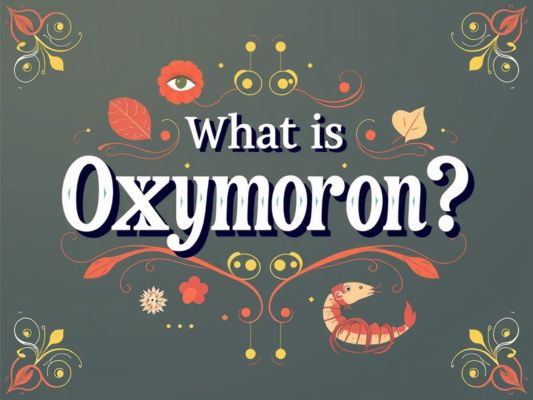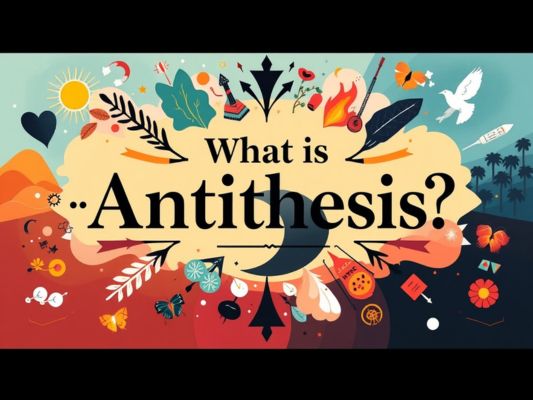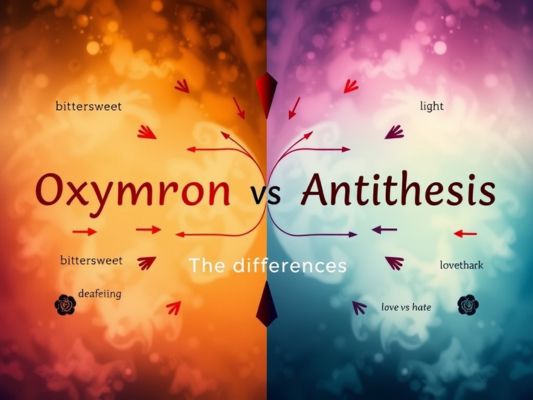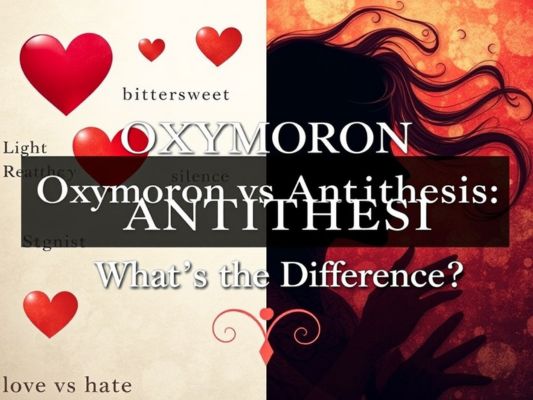Oxymoron vs antithesis are both literary devices that show contrasts. An oxymoron pairs two opposite words together, like “deafening silence.” Antithesis compares two opposing ideas in a sentence, like “It was the best of times, it was the worst of times.”
Have you ever heard of “bittersweet” or “jumbo shrimp”? These are oxymorons that mix opposites. It’s amazing how these devices make language more interesting and fun.
Oxymoron creates tension with two opposite words. Antithesis, on the other hand, emphasizes contrast between ideas. Both add depth to writing and help convey complex meanings in simple ways.
Understanding how literary devices like oxymoron vs antithesis work can transform your writing. These figures of speech are used to emphasize contrasting concepts and create deeper meaning in language.
While they seem similar, they have distinct roles in adding richness to figurative language. This article will break down their definitions, examples, and applications.
What is Oxymoron?

An oxymoron definition explains it as a figure of speech that combines two contradictory terms. This pairing creates a semantic ambiguity that draws attention to the phrase.
For instance, “bitter sweet” blends opposing emotions into a single expression, making it memorable. Writers often use oxymorons to evoke irony in language or add complexity to their work.
The purpose of oxymoron is to challenge readers. It invites them to think beyond the surface and find meaning in the tension of contrasting elements in speech. \This makes it a popular tool in creative expression in writing, from poetry to advertisements. Shakespeare, for example, frequently used oxymorons, such as in “Romeo and Juliet” when Juliet says, “Parting is such sweet sorrow.”
Examples of Oxymoron
There are many examples of oxymorons in literary imagery with contrast. Words like “jumbo shrimp,” “deafening silence,” and “organized chaos” are widely recognized. These phrases capture attention by combining opposite phrases in literature into meaningful contradictions.
Below is a table showcasing common oxymoron examples:
| Oxymoron Phrase | Explanation |
|---|---|
| Bittersweet | Combines joy and sadness |
| Living dead | Highlights the paradox of zombies |
| Awfully good | Uses extreme contrast for emphasis |
| Original copy | Points out the paradox of duplication |
Origins of Oxymoron
The word “oxymoron” comes from the Greek words “oxy” (sharp) and “moros (foolish).” This etymology highlights its contrastive phrases, where opposites coexist. It has been used for centuries to craft complex expressions in poetry, prose, and even persuasive writing techniques like slogans.
Early writers in classical literature often employed oxymorons to emphasize human contradictions or life’s unpredictability. Their continued use in modern writing showcases their lasting appeal.
What is Antithesis?

An antithesis involves the juxtaposition of two opposing ideas within a balanced structure. Unlike oxymorons, which combine opposites in a single phrase, antithesis sets up a clear contrast in literature through parallel sentences or clauses. For example, in Charles Dickens’ “A Tale of Two Cities,” the line “It was the best of times, it was the worst of times” exemplifies balanced contrast.
The impact of rhetorical devices like antithesis lies in their ability to highlight contrasting concepts clearly. This makes them effective for persuasion, as they provide emphasis through opposition. Political speeches and essays often use antithesis to strengthen arguments and create poetic devices that resonate with the audience.
Examples of Antithesis
Famous antithesis examples include rhetorical statements that stress literary contrasts for emphasis. Patrick Henry’s famous quote, “Give me liberty, or give me death,” illustrates rhetorical opposites. Similarly, Neil Armstrong’s line, “That’s one small step for man, one giant leap for mankind,” contrasts scale and significance.
Here is a table highlighting examples:
| Antithesis Statement | Purpose |
| “Speech is silver, silence is gold.” | Contrasts value of speaking vs listening |
| “To err is human; to forgive, divine.” | Shows human flaws and divine qualities |
| “Many are called, but few are chosen.” | Emphasizes rarity amidst abundance |
Origins of Antithesis
Antithesis has deep roots in speech techniques from ancient Greece and Rome. Thinkers like Aristotle used literary devices to teach effective use of paradox. Roman orators like Cicero refined it, making it a staple in persuasive writing techniques. Its clarity and balanced structure make it timeless.
Modern writers continue to use antithesis in both formal and creative writing. It is especially popular in speeches, where contrastive phrases strengthen the emotional appeal.
Oxymoron vs Antithesis: The Differences

While both tools rely on contrasting elements in speech, their methods differ. An oxymoron combines opposites into a single phrase, while antithesis places opposing ideas side by side in parallel form. Oxymorons focus on semantic ambiguity, creating tension within one idea. Antithesis, however, emphasizes rhetorical opposites to clarify a point.
The table below outlines the key differences:
| Feature | Oxymoron | Antithesis |
| Structure | Contradictory terms in one phrase | Parallel contrasting concepts |
| Purpose | Adds irony or ambiguity | Highlights balanced contrast |
| Examples | “Cold fire,” “jumbo shrimp” | “It was the best of times…” |
How to Use Oxymoron and Antithesis in Sentences
Using Oxymoron
Incorporate oxymorons in creative expression in writing to evoke irony or emotional depth. For example, phrases like “heavy lightness” can add layers of meaning. Ensure they fit naturally into your writing style, whether in poetry or advertising slogans. Subtle use avoids overwhelming the reader.
Using Antithesis
Antithesis works best in persuasive writing techniques. Use it to clarify points or emphasize choices. For instance, contrasting ideas like “Freedom is not free” create tension in language. Balance is key to making your rhetorical devices impactful.
Examples of Oxymoron and Antithesis Used in Sentences
Oxymoron
“The silence was deafening,” illustrates irony in language. It juxtaposes sound with quiet to create an emotional effect. Similarly, “old news” contrasts time to highlight redundancy.
Antithesis
“We must learn to live together as brothers or perish together as fools” demonstrates emphasis through opposition. It uses literary imagery with contrast to stress unity over division.
Combined Use of Oxymoron and Antithesis
“Dark light filled the room as hope fought despair” combines the complexity of meaningful contradictions with poetic devices. This dual technique creates profound imagery.
Common Mistakes to Avoid When Using Oxymoron and Antithesis
Writers often overuse these rhetorical devices, diluting their impact. Misplacing them in formal documents or casual contexts can confuse readers. Avoid using too many oxymorons or overly complex contrastive phrases in one piece.
Tips for Avoiding These Mistakes
Plan the placement of literary contrasts carefully. Always consider the tone and purpose of your writing. Test the balance between creativity and clarity.
Where to Use Oxymoron and Antithesis
These tools work well in persuasive language, creative writing, and speeches. Oxymorons shine in poetry and branding, while antithesis strengthens arguments in essays or debates.
Where Not to Use Oxymoron and Antithesis
Avoid these devices in technical or highly formal writing. They might distract readers or make the content feel less precise.
FAQs
Can I use oxymoron and antithesis together?
Yes, combining them can create powerful imagery and emotional depth, especially in creative writing.
Why are these tools effective?
They add layers of meaning, enhance persuasive arguments, and make writing more engaging through contrast.
How does oxymoron create impact in writing?
Oxymoron creates impact by blending contradictory terms, sparking curiosity, and evoking deeper emotions in the reader.
In what contexts is antithesis most commonly used?
Antithesis is often used in speeches, essays, and poetry to emphasize contrasting ideas and strengthen arguments.
Are oxymoron and antithesis only used in literature?
No, they are also used in everyday speech, advertising, and music to make messages more memorable and impactful.
Conclusion
Oxymoron and antithesis are powerful tools in writing and speaking. Oxymoron combines opposite words to create a single unique idea, like “living dead.” Antithesis contrasts two opposing ideas in a balanced way, like “good versus evil.” Both help writers and speakers express ideas clearly and creatively. They also make messages more interesting and easier to remember.
Understanding oxymoron vs antithesis can improve your communication skills. Oxymorons are great for showing complexity in a single thought. Antithesis is perfect for making strong comparisons or highlighting contrasts. You can use both to add depth to your writing and make it stand out. With practice, these techniques can help you express yourself more clearly and effectively.
With 5 years of experience in grammar, I, Admin, deliver accurate, clear, and reliable content. My expertise ensures top-quality insights in this niche.

